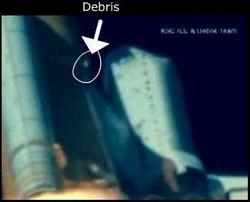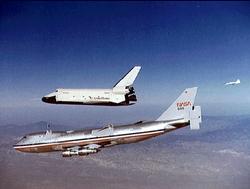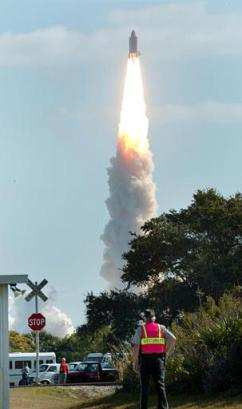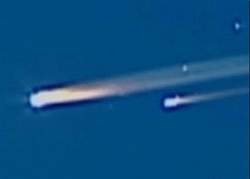Could Launch Damage Have Caused Disaster?
 Researchers took a piece of insulating foam from a
shuttle fuel tank, fired it at an aluminum sheet Friday, and
watched the results. All this, in preparation for tests requested
by the Columbia accident investigators to take place later
this month.
Researchers took a piece of insulating foam from a
shuttle fuel tank, fired it at an aluminum sheet Friday, and
watched the results. All this, in preparation for tests requested
by the Columbia accident investigators to take place later
this month.
The investigation board wants to measure the amount of damage
caused by insulating foam striking actual shuttle wing parts at
nearly 500 mph. These test-firings at Southwest Research Institute
should help determine whether the blow to Columbia's left
wing by a 2-pound piece of foam during liftoff was enough to lead
to the ship's destruction two weeks later.
The foam broke off Columbia's external fuel tank barely
a minute into the flight and slammed into the leading edge of the
wing.
Enterprise Answers Call For Help
 NASA called the institute for help in setting up
the tests two days after the shuttle disintegrated over Texas
during re-entry. Justin Kerr, NASA's director of the impact test
program, said the space agency immediately began seeking expert
help in finding the cause of the Feb. 1 accident that killed seven
astronauts.
NASA called the institute for help in setting up
the tests two days after the shuttle disintegrated over Texas
during re-entry. Justin Kerr, NASA's director of the impact test
program, said the space agency immediately began seeking expert
help in finding the cause of the Feb. 1 accident that killed seven
astronauts.
For the monthlong series of tests scheduled to begin in
mid-April, NASA will shoot foam at wing panels from the shuttle
Discovery and the Enterprise, a prototype that
never flew and is now housed at the Smithsonian Institution.
Because those targets are so precious, NASA and the institute
want to make sure the giant compressed-gas gun and all the
measuring instruments are thoroughly checked out and working
perfectly.
 "The test articles themselves are so expensive. I
mean, you just can't come out here and do 50 shots," said Scott
Mullin, manager of the institute's ballistics and explosives
engineering section.
"The test articles themselves are so expensive. I
mean, you just can't come out here and do 50 shots," said Scott
Mullin, manager of the institute's ballistics and explosives
engineering section.
Mullin acknowledged that the outdoor testing at the institute's
ballistic range cannot precisely recreate the weather or certain
other conditions during a shuttle liftoff. Computer simulations
will help with that.
"In the Sherlock Holmes world, it's one piece of the pie," he
said.
For Friday's test, a 1.25-pound piece of foam about the size of
a briefcase shot through the 33-foot barrel of the
nitrogen-pressurized gun at an aluminum sheet. The sheet was
mounted on a metal frame several feet in front of the gun, and
tilted at a 15-degree angle.
"Five, four, three, two, one, zero," Larry, the gunner, called
out. A few more seconds passed, and then the foam whooshed with a
loud crack out of the barrel and struck the lower center of the
aluminum sheet, right where it was aimed.
Shredded pieces of foam fluttered into the trees behind the test
stand; some were as big as a loaf of French bread. The aluminum
wasn't dented, but the foam left a mark.
Officials called the test a success.
But Will The Testing Tell The Tale?
 Neither Mullin nor Kerr would offer an opinion on whether foam
could have caused catastrophic damage to Columbia's left
wing. Tests at the institute in 1999, shooting much smaller pieces
of foam at thermal tiles - but not wing panels - sometimes resulted
in little damage, Mullin said.
Neither Mullin nor Kerr would offer an opinion on whether foam
could have caused catastrophic damage to Columbia's left
wing. Tests at the institute in 1999, shooting much smaller pieces
of foam at thermal tiles - but not wing panels - sometimes resulted
in little damage, Mullin said.
"What we're doing here is not necessarily going to say, `Yeah
that's it or not,'" Mullin said.
"If we do test out here and there's like zilch-o damage, then
they're going to have to go back and look at it and say, `it was
something else.' I don't think there's going to be zilch
damage."
 ANN's Daily Aero-Term (05.17.24): Very High Frequency
ANN's Daily Aero-Term (05.17.24): Very High Frequency ANN's Daily Aero-Linx (05.17.24)
ANN's Daily Aero-Linx (05.17.24) ANN FAQ: Submit a News Story!
ANN FAQ: Submit a News Story! Classic Aero-TV: ANN Visits Wings Over The Rockies Exploration Of Flight
Classic Aero-TV: ANN Visits Wings Over The Rockies Exploration Of Flight Airborne Affordable Flyers 05.16.24: PRA Runway, Wag-Aero Sold, Young Eagles
Airborne Affordable Flyers 05.16.24: PRA Runway, Wag-Aero Sold, Young Eagles






